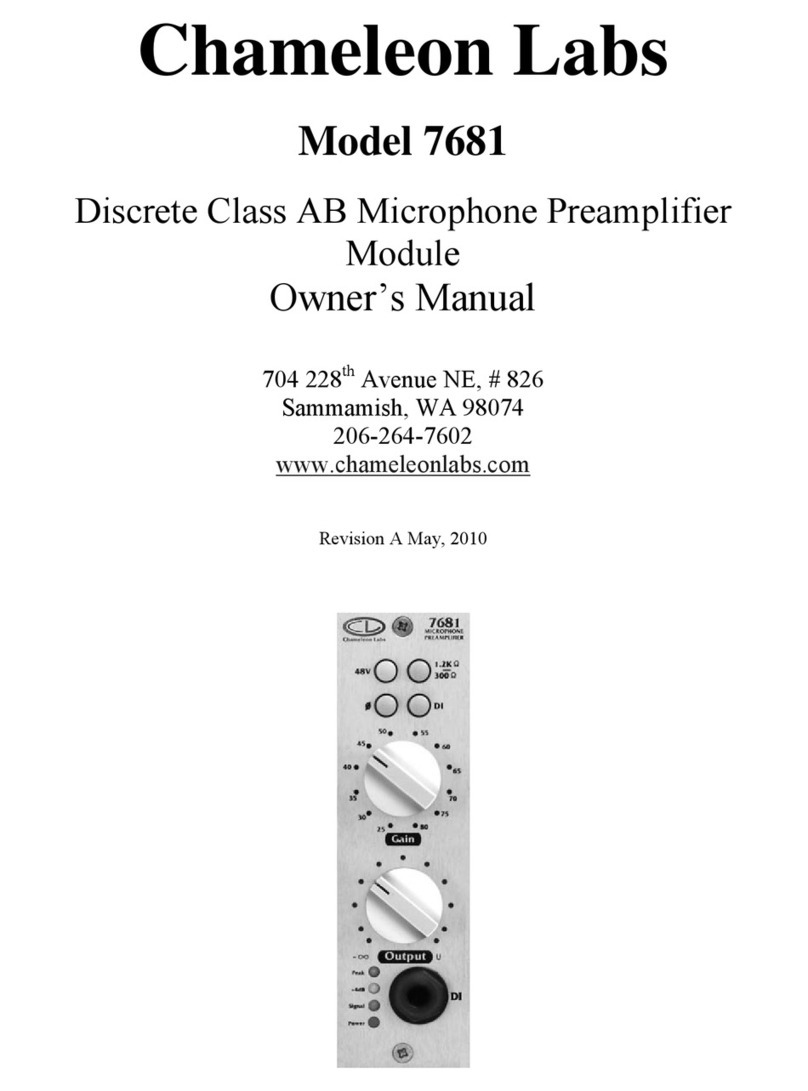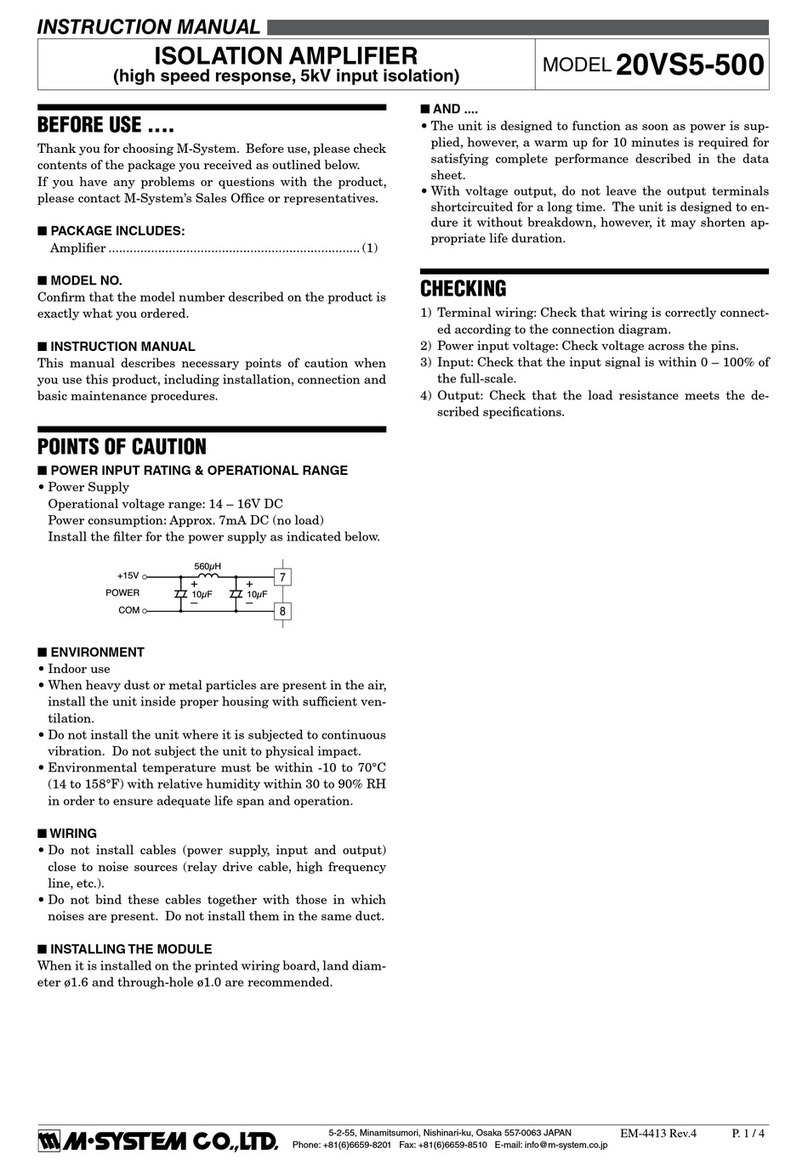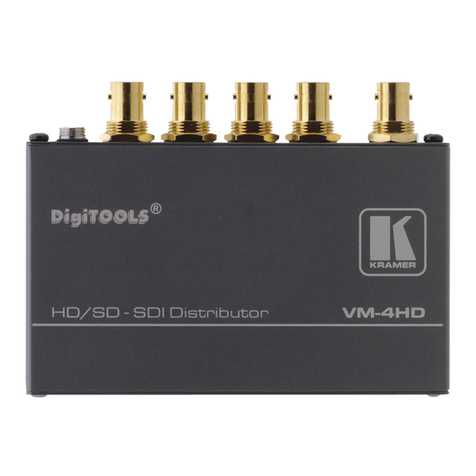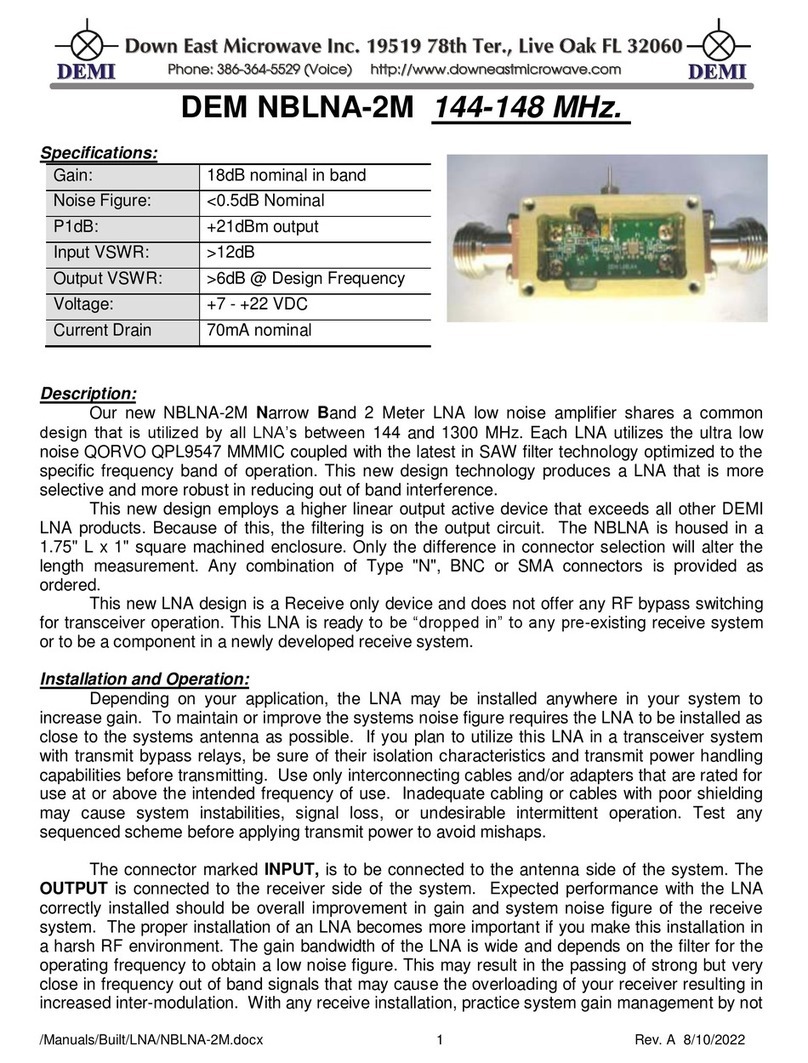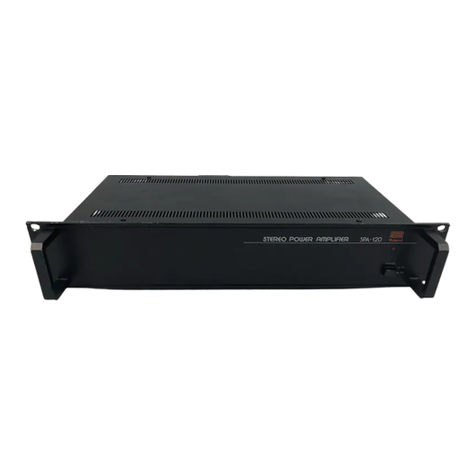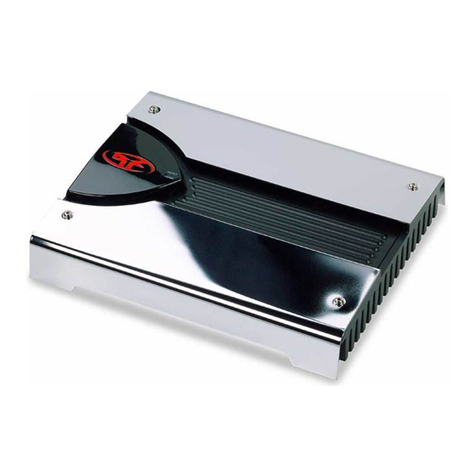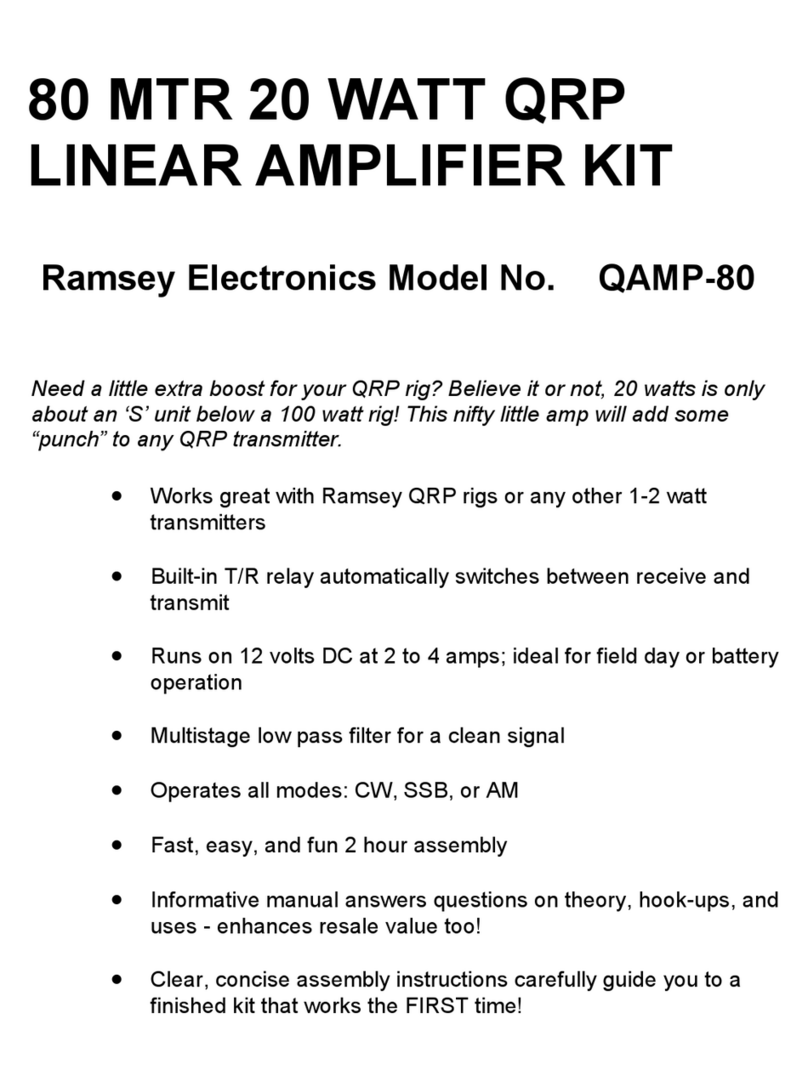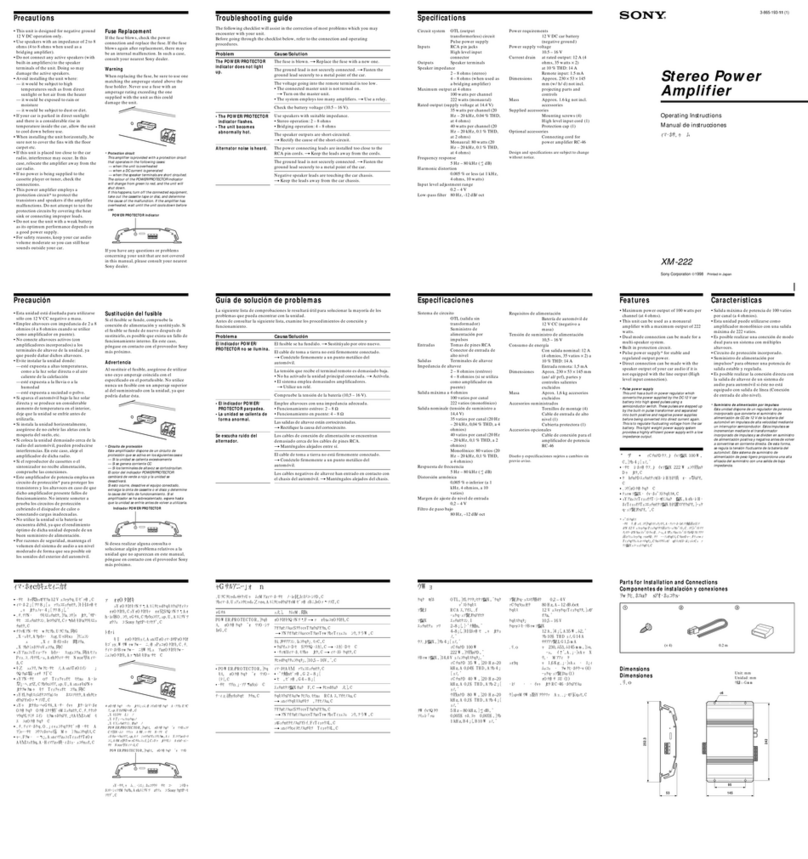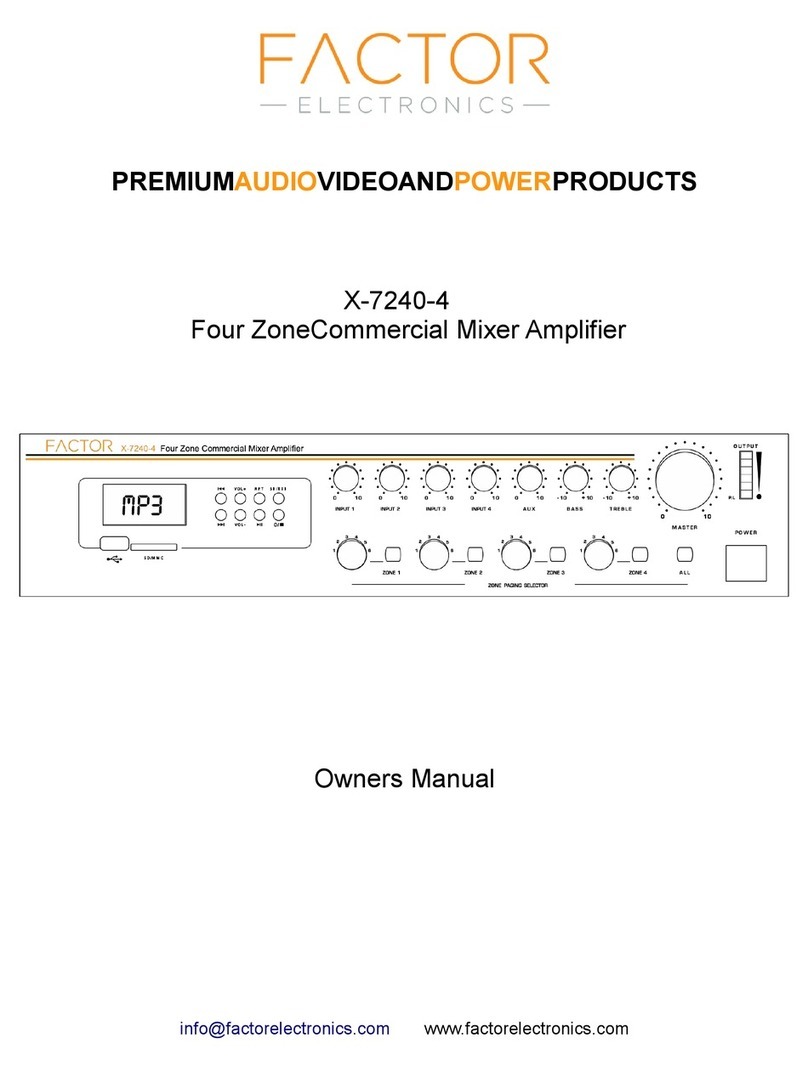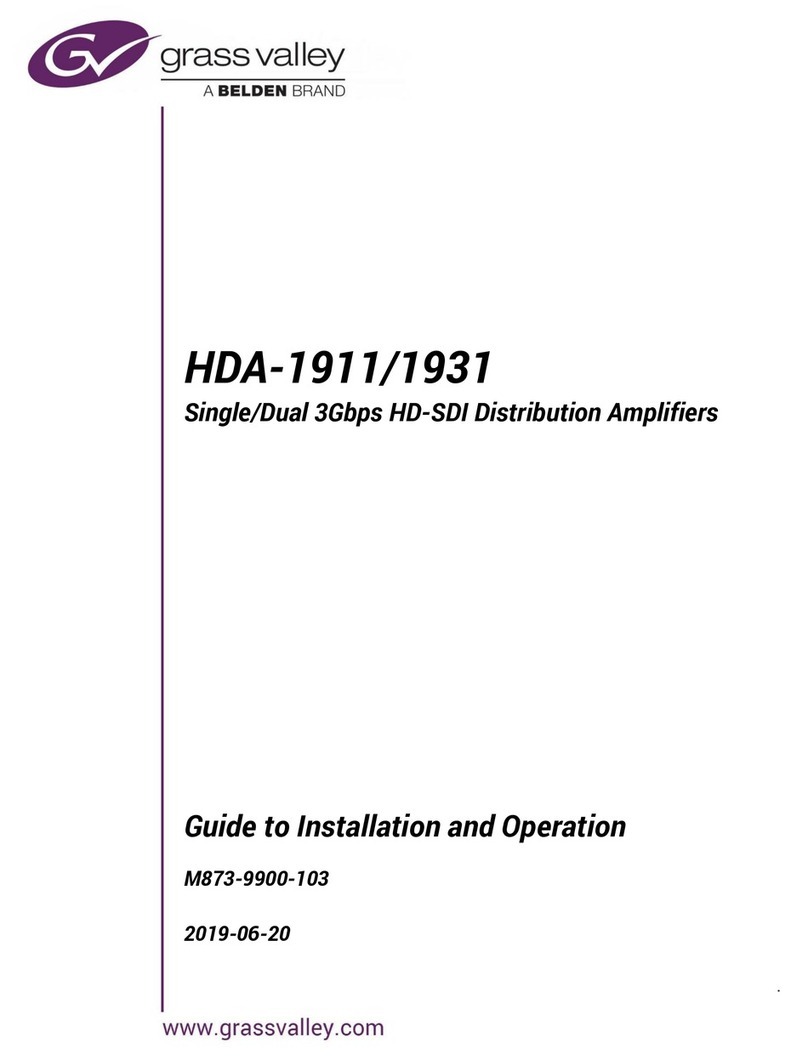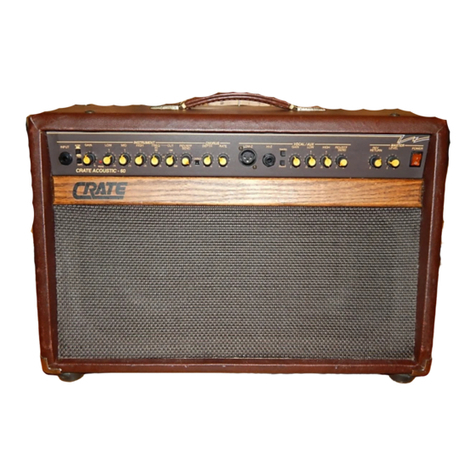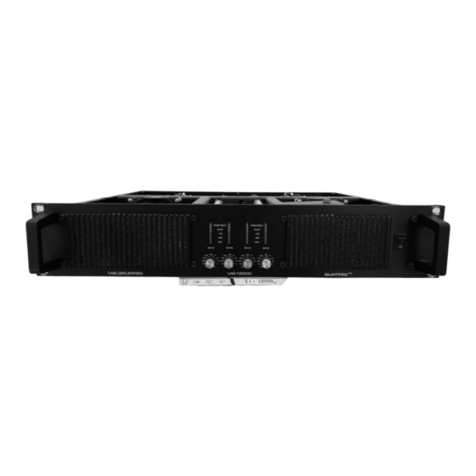Chameleon Labs 7603 User manual

1
Chameleon Labs LLC, Woodinville, WA USA www.chameleonlabs.com 7603 User’s Manual
User’s Manual
7603 Mic/Line Pre-Amplier
7603 XMod Mic/Line Pre-Amplier

2
Chameleon Labs LLC, Woodinville, WA USA www.chameleonlabs.com 7603 User’s Manual
Important Safety Instructions
1. Read these instructions.
2. Keep these instructions.
3. Heed all warnings.
4. Follow all instructions.
5. Do not use this apparatus near water.
6. Clean only with a dry cloth.
7. Do not block any ventilation openings.
Install in accordance with the manufacturer’s
instructions.
8. Do not install near any heat sources such as
radiators, heat registers, stoves, or other
apparatus (including amplifiers) that produce
heat.
9. Protect the power cord from being walked on
or pinched particularly at plugs, convenience
receptacles, and the point where they exit from
the apparatus.
11.
Only use attachments/accessories specified by
the manufacturer.
12.
Use only with a cart, stand, tripod, bracket, or
table specified by the manufacturer, or sold with
the apparatus. When a cart is used, use caution
when moving the cart/apparatus combination
to avoid injury from tip-over.
13.
Unplug this apparatus during lightning storms
or when unused for long periods of time.
14.
Refer all servicing to qualified service
personnel. Servicing is required when the
apparatus has been damaged in any way, such
as power-supply cord or plug is damaged, liquid
has been spilled or objects have fallen into the
apparatus, the apparatus has been exposed to
rain or moisture, does not operate normally, or
has been dropped.
15.
This apparatus shall not be exposed to dripping
or splashing, and no object filled with liquids,
such as vases or beer glasses, shall be placed on
the apparatus.
The lightning flash with arrowhead
symbol within an equilateral triangle is
intended to alert the user to the presence
of uninsulated “dangerous voltage”
within the product’s enclosure, that may be
of sufficient magnitude to constitute a risk of
electric shock to persons.
Le symbole éclair avec point de flèche à l’intérieur
d’un triangle équilatéral est utilisé pour
alerter l’utilisateur de la présence à l’intérieur
du coffret de “voltage dangereux” non isolé
d’ampleur suffisante pour constituer un risque
d’éléctrocution.
The exclamation point within an
equilateral triangle is intended to alert
the user of the presence of important
operating and maintenance (servicing)
instructions in the literature accompanying the
appliance.
Le point d’exclamation à l’intérieur d’un
triangle équilatéral est employé pour alerter
les utilisateurs de la présence d’instructions
importantes pour le fonctionnement et
l’entretien (service) dans le livret d’instruction
accompagnant l’appareil.
Caution: to reduce the risk of electric shock, do
not remove cover (or back). No user-serviceable
parts inside Refer servicing to qualified
personnel
Attention: pour eviter les risques de choc
Electrique, ne pas enlever le couvercle. Aucun
Entretien de pieces interieures par l’usager.
Confier L’entretien au personnel qualifie.
Avis: pour eviter les risques d’incendie ou
D’electrocution, n’exposez pas cet article A la
pluie ou a l’humidite
At the end of its useful life, this product must
be carefully and correctly disposed of, and
not placed in with household waste. Please
contact your local, state, or national services
for information regarding the safe disposal of
electronic equipment.
CAUTION AVIS
RISK OF ELECTRIC SHOCK
DO NOT OPEN
RISQUE DE CHOC ELECTRIQUE
NE PAS OUVRIR

3
Chameleon Labs - Vercelli 3 LLC, Woodinville, WA USA www.chameleonlabs.com 7603 User’s Manual
Introduction
Congratulations on your purchase of a fine
Chameleon Labs’ 7603 microphone/line preamplifier.
We hope that it gives you many years of reliable and
high-quality service.
Your Model 7603 has a transformer-balanced input
with a range between +20 dB and +70 dB of gain. The
separate line input is also transformer balanced
and accepts input levels from -30 to +20 dB. The
equalizer section is a selectable 3-band design with a
flexible filter section.
The Model 7603 has been carefully constructed and
individually tested for quality. It utilizes pure class
‘A’ circuitry. This unit is made with 100% discrete
components, with custom-wound transformers, and is
fabricated to precisely match vintage counterparts
manufactured in the early to mid 70’s.
The Model 7603 is based on high audio performance
design techniques. By employing classic circuit
design, film capacitors, a mechanical gain
selector and custom wound transformers, Chameleon
Labs ensures that the Model 7603 will exhibit classic
audio sound.
Your Model 7603 represents a dramatic breakthrough
in delivering vintage audio performance at an
affordable price.
Features:
• Chameleon Microphone and Line Input
Transformers w/ mumetal housings
• Hi-Z Front Panel Direct Instrument Input (TRS)
• Chameleon Output Transformer
• Discrete Class A Electronic Topology
• Variable gain, low noise output stage
• 48V Phantom Mic Power
• Input and Output Level Monitoring via VU Meter
• Selectable 300Ωor 1200ΩMic Input Impedance
• Inductor Based Equalization and High Pass
Circuit
• Universal on board power supply
Front Panel Features
• Rack-mountable, one rack-space high, 19 inches
wide
• Mic/Line Gain rotary detented selector switch
• High-pass-filter frequency selector
• Low EQ frequency and amplitude selectors
• Mid EQ frequency and amplitude selectors
• High EQ frequency and amplifier selectors
• Output level control
• Power ON/OFF switch
• 300Ωor 1200ΩMic Input Impedance Selector
• 48V Phantom Power ON/OFF switch
• Mic/Line switch
• DI input ON/OFF switch
• EQ ON/OFF switch
• Phase 0/180 degree switch
• DI 1/4” TRS input
• LEDs for input and output overload
• Illuminated input/ouput meter with dB range
switch
Rear Panel Features
• AC Power Input and integral fuseholder
• XLR Microphone input
• XLR Line input
• XLR Output
Power Supply
• Internal universal power supply
Limited Warranty
• One year

4
Chameleon Labs LLC, Woodinville, WA USA www.chameleonlabs.com 7603 User’s Manual
Front Panel Features
1. Front Panel
This rack-mountable front panel is one
rack-space high and 19 inches wide. Four
mounting holes accept standard rack screws
for securing the preamplifier in a rack.
2. DI Input
This high-impedance input can be used to
connect an instrument directly to the 7603.
Place the DI switch (3) to “ON” and the Mic/
Line switch must be set to “Line”.
The ¼”TRS connector is wired with the TIP
positive, the RING negative and the SLEEVE
ground (shield).
3. DI on/off switch
Use this switch to turn the DI output on or
off. Set it in the OFF position if you are not
using the DI input.
4. Mic/Line switch
This switch allows you to select either the
microphone input section, or line-level input
section. The microphone and line inputs each
have their own input connectors on the rear
panel, and separate input transformers.
5. Mic Impedance switch
This switch allows you to select between an
impedance of 300 Ωor 1.2 kΩ. Follow the
advice from your microphone manufacturer.
6. Mic/Line Gain
This detented selector switch allows you to
adjust either the gain of the microphone
input section, or the gain of the line-level
input section. The microphone and line inputs
have their own input connectors on the rear
panel, and separate input transformers. Use
the Mic/Line selector switch (4) to select the
input you would like to listen to.
Microphone
The microphone gain is adjustable from
+20 to +70 dB, in steps of 5 dB. Use the
dB markings on the outer ring of the Gain
control for setting the microphone level.
Line
The line input gain is adjustable from -30 to
+20 dB, in steps of 5 dB. Use the dB markings
on the inner ring of the Gain control for
setting the line level.
Adjust the gain carefully, so the input
section is not too overloaded with a strong
signal, and that weaker signals are boosted
sufficiently. Have the gain set to minimum
before turning on the preamplifier, then
increase the gain as desired.
7. Ovr LED
This LED will light when the input levels are
overloaded. Carefully adjust the Gain knob
(6) so this LED does not come on during
louder passages.
8. 48V switch
If your microphone requires 48 Volt Phantom
Power, turn on this switch.
Caution: Be very careful because
some microphones can be damaged
by Phantom Power. Read and follow the
manufacturer’s recommendations for your
microphone before using this switch.
9. EQ ON/OFF switch
In the ON position, the signal EQ is
adjustable using the EQ controls. In the OFF
position, they have no effect and the EQ
section is bypassed. This provides a quick
way of comparing your EQ settings with the
unaffected original signal.
2 3 61 8 11 12 13 14 15 16 17 18 20 21
22199 105 74 23

5
Chameleon Labs LLC, Woodinville, WA USA www.chameleonlabs.com 7603 User’s Manual
10. Phase Reversal
This allows you to change the signal phase by
180 degrees. This is useful when comparing
the sound of your microphone or instrument
within the mix. Imagine if a note is played,
and the speaker cone is moving out. With
the phase reversed, the speaker cone would
instead be moving in at that moment.
11. High-Pass filter
This detented selector switch allows you to
select the frequency of the high pass filter.
Signals below this frequency are attenuated
with an 12 dB per octave slope. This filter is
useful for removing low-frequency effects
such as mic-handling and stage noise, rumble
etc. The crossover frequency can be selected
from OFF, 40, 80, 160, and 320 Hz. In the OFF
position, the high-pass filter is bypassed and
the low-frequencies are not affected.
12. Low EQ frequency
This detented selector switch allows you to
select the frequency of the low EQ shelving
filter. Signals below this frequency are
boosted or attenuated depending on the
setting of the Low EQ amplitude control (13).
The available frequency selections are 35, 60,
110, and 220 Hz. In the OFF position, the Low
EQ is bypassed.
13. Low EQ amplitude
This continuously-variable control allows
you to boost or attenuate the level at the
frequency set by the Low EQ frequency
control (12). The level of adjustment is from
-15 to +15 dB
14. Mid EQ frequency
This detented selector switch allows you to
select the frequency of the Mid EQ peaking
filter. Signals around this frequency are
boosted or attenuated depending on the
setting of the Mid EQ amplitude control (15).
The available frequency selections are 350,
700, 1.6k, 3.2k, 4.8k, and 7.2 kHz. In the OFF
position, the Mid EQ is bypassed.
15. Mid EQ amplitude
This continuously-variable control allows
you to boost or attenuate the level at the
frequency set by the Mid EQ frequency control
(14). The level of adjustment is from -15 to
+15 dB
16. High EQ frequency
This detented selector switch allows you to
select the frequency of the High EQ shelving
filter. Signals above this frequency are
boosted or attenuated depending on the
setting of the High EQ amplitude control
(17). The available frequency selections are
3.4k, 4.9k, 7k, 12k, and 16 kHz. In the OFF
position, the High EQ is bypassed.
17. High EQ amplitude
This continuously-variable control allows
you to boost or attenuate the level at the
frequency set by the High EQ frequency
control (16). The level of adjustment is from
-15 to +15 dB
18. Output Gain
This continuously-variable control allows
you to adjust the level of the output from
-60 dB to +20 dB. Acting as a console fader,
this control is placed after the gain stage
and before the output stage. This allows
for trimming of the input signal between
the 5 dB steps of the input switch, as well
as allowing the input to be intentionally
overdriven. The normal position for this
control is wide open.
19. Ovr LED
This LED will light when the output levels are
overloaded. Carefully adjust the Output Gain
control (18) so this LED does not come on.
during louder passages.
20. Meter
This precision VU meter shows either the
input or output levels, depending upon the
position of the input/output switch (23). Use
the dB range switch (21) to select the meter
sensitivity.
21. dB Range
Use this to select the dB range of the meter
from 0 dB or -20 dB.
22. Power Switch
When all your connections to and from the
preamplifier have been made, use this switch
to turn the unit on or off.
23. VU Meter switch
Use this to select if the meter shows the input
signal level or the output signal level.

6
Chameleon Labs LLC, Woodinville, WA USA www.chameleonlabs.com 7603 User’s Manual
Rear Panel Features
1. AC Power Input
The unit contains a universal power supply
that will operate with AC mains voltages from
100 VAC to 240 VAC at 50/60 Hz.
Connect one end of the supplied AC power
cord to this input, and the other end to an AC
mains supply.
The AC input has its own integral fuseholder.
Before changing or inspecting the AC fuse,
turn off the unit and unplug the power cord
from the AC mains supply. Use only the
specified fuse. If the fuse is replaced and
blows again, please contact your dealer for
repair. DO NOT use a larger fuse.
2. Output
Connect this to the line-level input section
of a mixer, or the line-level input of a power
amplifier, or to other devices such as Analog
to Digital converters etc.
This male XLR connector is wired with
pin 2 HOT, pin 3 common, and pin 1 ground
(shield).
3. Microphone input
Connect your microphone to this input. The
preamplifier can supply 48V phantom power
through this input to your microphone, if
your microphone requires phantom power.
This female XLR connector is wired with pin
2 HOT, pin 3 common, and pin 1 ground
(shield). The 48 VDC phantom power is
supplied on pins 2 and 3.
4. Line input
Connect the output of your line-level
device to this input, for example, the line-
level output from a keyboard or a guitar
preamplifier.
This female XLR connector is wired with pin
2 HOT, pin 3 common, and pin 1 ground
(shield).
1 2 3 4

7
Chameleon Labs LLC, Woodinville, WA USA www.chameleonlabs.com 7603 User’s Manual
Initial set up of the Model 7603
1. Select +40 dB on the Microphone / Line
sensitivity control. Turn the Output control
fully counter clockwise. Make certain that the
DI, 48V, EQ and Phase switches are all off. Set
the Mic/Line input selector to MIC.
2. Connect a microphone to the female
XLR connector on the rear panel. If the
microphone requires Phantom Power,
switch the 48V on. Be very careful, as some
microphones can be damaged by phantom
power.
3. The normal position for the 300/1.2K
impedance switch is 1.2K. This matches most
professional microphones used today; if your
microphone requires a lower impedance,
you may toggle the switch to 300. You can
toggle between the selections without
damage to the microphone to determine
which impedance performs better for your
application.
4. Connect the rear panel Output male
XLR connector, to the input XLR connector
on your mixer, recorder, or digital audio
workstation (DAW).
(If you are sending to a device that does not
have a gain control, use the Output control
to adjust your signal so that your loudest
signals just fail to reach the maximum input
levels on your recording device.)
5. Turn the Output control clockwise until you
can see level on the input of your recorder.
Increase until the desired level is achieved.
(Vintage Hint: Adjusting the
Microphone/Line Gain control along with
the Output control can provide a variety a
different sounds by overdriving the amplifier
circuits while lowering the final output level
in order to not overdrive the recorder.)
6. If you wish to connect the equalizer section
to the line output of your board or DAW,
simply connect to the Line Input female XLR
connector on the rear panel.
7. To insert the equalization section into the
circuit, toggle the EQ switch. Each section
can be set to OFF with the frequency selector
knob. As you add or subtract gain within the
equalizer, be sure to adjust your overall gain
with the output control. When the output
control can no longer make the adjustments
that you need, you may switch to a higher or
lower gain setting on the Microphone / Line
Gain control.
8. When an electronic instrument such as an
electric guitar is used, it may be plugged
directly into the ¼"DI plug located on the
front panel. Toggle the Line/Mic switch to
“Line” and the DI switch to “ON”.
9. If phase reversal is needed or you want to
try its effect, toggle the phase switch (a zero
symbol with a diagonal line through it).

8
Chameleon Labs LLC, Woodinville, WA USA www.chameleonlabs.com 7603 User’s Manual
General Specifications
Noise Better than -125dBm EIN between -80 and
-40 dBm referenced to 600Ωinput imped-
ance, SNR 116dB at maximum output
Output Type Transformer balanced and floating to drive
600 Ωload
Maximum Output +28 dBu into 600Ωload impedance
Frequency Response 10Hz - 20kHz -0.5 dB
10Hz - 50kHz -1 dB
Indicators
Meter Light
Power ON
Red
Input Overload
Red
Output Overload
Internal Power Supply
100 to 240 VAC (50/60 Hz)
Switch mode power supply, fully shielded
Quiescent Consumption 0.5 Watts
Peak Output 3 Amp
User Controlled Functions
ON Switch Turn Pre Amp ON - VU meter light on
300Ω/ 1200ΩSwitch Switch between 300Ωand 1200Ωinput
impedance for the mic input
48V Power Supply Switch ON/Off
DI Switch (Line Input Selected) Direct Input with 100KΩinput sensitivity
EQ Switch Engages audio high pass filter and equaliza-
tion circuits
Polarity Switch Reverses the polarity of the audio signal
Mic/Line Switch Switch between Mic or Line inputs
Mic/Line Sensitivity Switch 20dB to 70dB of mic boost and -30dB to
+20dB of line level adjustment.
High Pass Filter Provides a 12dB/octave high pass filter at
40Hz, 80Hz, 160Hz and 320Hz
Low Frequency Equalization Provides +/-15 db of Boost or Cut at 35Hz,
60Hz, 110Hz or 220Hz
Mid Frequency Equalization Provides +/-15 db of Boost or Cut at 360Hz,
700Hz, 1.6kHz, 3.2kHz, 4.8kHz or 7.2kHz
High Frequency Equalization Provides +/-15 db of Boost or Cut at 3.4kHz,
4.9kHz, 7kHz, 12kHz or 16kHz
Inputs
Microphone (XLR) Transformer balanced input, RF isolated
Line (XLR) Transformer balanced input, RF isolated
Direct In (1/4” TRS) High impedance instrument input
Input Impedance
Microphone 300Ωor 1200Ω
Line 10kΩline bridging from 600Ωor lower
source impedance
Direct Input 100kΩ
Sensitivity
Microphone From -70dBm to -20dBm in 5 dB steps for
0dBm output
Line From -30 dBm to +20 dBm in 5 dB steps for 0
dBm output
Physical Specifications
Depth
280mm / 11.02 inches
Height
44.5mm / 1.75 inches (1 RU)
Width
480mm / 19 inches
Weight
4.54 kg / 10.0 lbs
Box Size
Depth
400mm / 15.75 inches
Height
150mm / 5.90 inches
Width
620mm / 24.4 inches
Weight
6.58 kg / 14.50 lbs
Chameleon Labs reserves the right to change these
specifications at any time without notice. Not to be a pain, but
to improve things in general.
Chameleon Labs is a trademark of Chameleon Labs LLC. All other brand
names mentioned are trademarks or registered trademarks of
their respective holders, and are hereby acknowledged.
©2016 Chameleon Labs. All Rights Reserved.

9
Chameleon Labs LLC, Woodinville, WA USA www.chameleonlabs.com 7603 User’s Manual
Typical Performance Graphs
The graphs below show the effect of the high-pass
filter controls and the Low, Mid, and High EQ. They
show the signal level change versus frequency.
This graph shows the
frequency response with
no high-pass filter or EQ
engaged.
High Pass Filter
The high-pass crossover frequency
can be selected from 40, 80, 160,
and 320 Hz. In the OFF position,
the high-pass filter is bypassed
and the low-frequencies are not
affected.
0
+3
+6
+9
-3
-6
-9
20 50 100 200 500 1k 2k 5k 10k 20k
50k
10
Hertz
dB
Frequency Response
+24
+18
+12
+6
0
-6
-12
-18
-24
20 50 100 200 500 1k 2k 5k 10k 20k
High Pass Filter - 40Hz, 80Hz, 160Hz and 300Hz
dB
Hertz

10
Chameleon Labs LLC, Woodinville, WA USA www.chameleonlabs.com 7603 User’s Manual
Typical EQ Performance Graphs
Low EQ
The available frequency selections
are 35, 60, 110, and 220 Hz, with
20 dB boost or cut. In the OFF
position, the Low EQ is bypassed.
Mid EQ
The available frequency selections
are 360, 700, 1.6k, 3.2k, 4.8k, and
7.2 kHz, with 20 dB boost or cut.
In the OFF position, the Mid EQ is
bypassed.
High EQ
The available frequency selections
are 3.4k, 4.9k, 7k, 12k, and 16 kHz,
with 20 dB boost or cut. In the OFF
position, the High EQ is bypassed.
+18
+15
+12
+6
0
-6
-12
-15
-18
20 50 100 200 500 1k 2k 5k 10k 20k
Low Frequency Shelving Filter - 35Hz, 60Hz, 110Hz and 220Hz
dB
Hertz
+18
+15
+12
+6
0
-6
-12
-15
-18
20 50 100 200 500 1k 2k 5k 10k 20k
Mid Frequency EQ - 360Hz, 700Hz, 1.6kHz, 3.2kHz and 7.2kHz
dB
Hertz
+18
+15
+12
+6
0
-6
-12
-15
-18
20 50 100 200 500 1k 2k 5k 10k 20k
High Frequency Shelving Filter - 360Hz, 700Hz, 1.6kHz, 3.2kHz and 7.2kHz
dB
Hertz

11
Chameleon Labs LLC, Woodinville, WA USA www.chameleonlabs.com 7603 User’s Manual

12
Chameleon Labs LLC, Woodinville, WA USA www.chameleonlabs.com 7603 User’s Manual
Warranty and Liability
Your Chameleon Labs product is warranted to the original owner for a period of one year. Chameleon
Labs guarantees this product to be free from electrical and mechanical defects and will repair or
replace defective components, or replace the unit at Chameleon Lab’s option. Should service be
required for your Chameleon Labs product, please contact the manufacturer. Service is provided for
products beyond the warranty period. Seller warrants that the goods are described in this agreement,
but no other express warranty is made in respect to the goods. The entire risk as to the quality and
performance of the good is with the buyer. Seller disclaims all warranties either expressed or implied,
including any implied warranty of merchantability or fitness for a particular purpose, and seller
neither assumes nor authorizes any other person to assume for it any liability in connection with the
sale of said goods.
MODEL NUMBER ----------------------------------------------------------------------------
SERIAL NUMBER ----------------------------------------------------------------------------
DATE OF PURCHASE ----------------------------------------------------------------------------
PURCHASED FROM ----------------------------------------------------------------------------
----------------------------------------------------------------------------
----------------------------------------------------------------------------
Please visit www.chameleonlabs.com for the latest updates and technical information.
This manual suits for next models
1
Table of contents
Other Chameleon Labs Amplifier manuals

